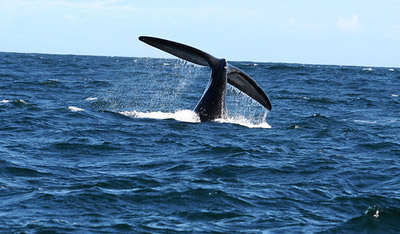5 Best Places For Whale Watching
It is spring in Cape Town and therefore it is time for some whale watching!
Between June and November whales come into the bays for the breeding season. During this period is the best time to spot whales! Before I tell you the five best places to observe these amazing creatures, I will tell you a bit more about whales and why they come close to land during these months.
Whales are large, loving and intelligent mammals. They breathe air, just like humans do. They come up to breathe via their blowholes every once in a while, which makes it easier to spot them. An adult whale can grow up to 15m long and eats about 4 tons of krill every day. A ‘bull’ is a male, a ‘cow’ is a female and the newborns are ‘calves’. They do not maintain a relationship but have several partners every season.
You can find whales all over the world in the oceans, though they migrate during the breeding season. Whales spend most of their lives in cold water, but when breeding they tend to return to the shallow and warmer waters. There are several species in the African waters, but the most common whales are the Humpback and the Southern Right whale.
South Africa’s Western Cape Province offers several excellent whale watching spots, here are my 5 Best places to see whales in the Western Cape, remember to pack your binoculars:
Hermanus is a town along the southern coast of the Western Cape province of South Africa and famous for its whale watching. This city lies about 115km from Cape Town and is easily reached by car via the R43 highway. At the end of September Hermanus hosts the annual whale festival. This event celebrates the whales coming into the bay for mating season and is a bustling attraction to visit.
Cape Point is the southernmost tip of the Cape Peninsula and dramatically positioned on the whales’ migration route when they travel over more than 5000km from the cold waters of the Antarctic to the warmer African waters. You can spot whales while relaxing and enjoying the spectacular views from the Cape of Good Hope Nature Reserve or go out on the ocean by boat.
Between Fish Hoek and Simon’s Town, the whales come every year to the stretches of kelp and rocks to give birth to their calves and to remove the barnacles they’ve accumulated. This place is easily accessible and a beautiful coastal drive.
The spectacular Chapman’s Peak Drive presents an elevated view of the entire Hout Bay area. Along this rocky road, you come by several places for whale watching. To spot the Southern Right whales don’t forget your binoculars.
Near the harbour of Hout Bay is Mariner’s Wharf. This is South Africa’s first harbour-front emporium. Besides the many attractions like the fish market, the bistros, restaurants, there is an opportunity for whale watching.
November’s coming closer, so grab your binoculars and get into your car to spot some whales!
Related Posts
10 Fun Things to Do in Cape Town Under R200
Looking for fun things to do in Cape Town under R200? You’re actually spoiled for choice. Cape Town is one of the world’s most beautiful cities and travellers come from all around to experience the mountain, coastline, and culture. Here at Drive South Africa, we’ve put together a list of 10 fun things to do […]
Read MoreTolwegen in Zuid-Afrika
Als u op zoek was naar de tolwegen calculator, helaas hebben we deze moeten verwijderen omdat Google een vrij groot bedrag is gaan vragen voor het gebruik van Google Maps. Onze oprechte excuses voor het ongemak. Waarom tolwegen tarieven in Zuid-Afrika? Tolwegtarieven worden gebruikt als een continue inkomstenstroom, wat betekent dat er altijd fondsen zullen […]
Read MoreThe Breathtaking Zebra Migration in Botswana
Each year, Botswana’s zebra journey between Okavango Delta and Makgadikgadi Pans in search of fresh grazing in what is known as the second largest zebra migration in the world. Scattered herds of Botswana’s national animal can be seen throughout the Makgadikgadi palm belt and near the salt pans where the mineral content of grasses is […]
Read More Rating: 4 - 1562 Reviews
Rating: 4 - 1562 Reviews




